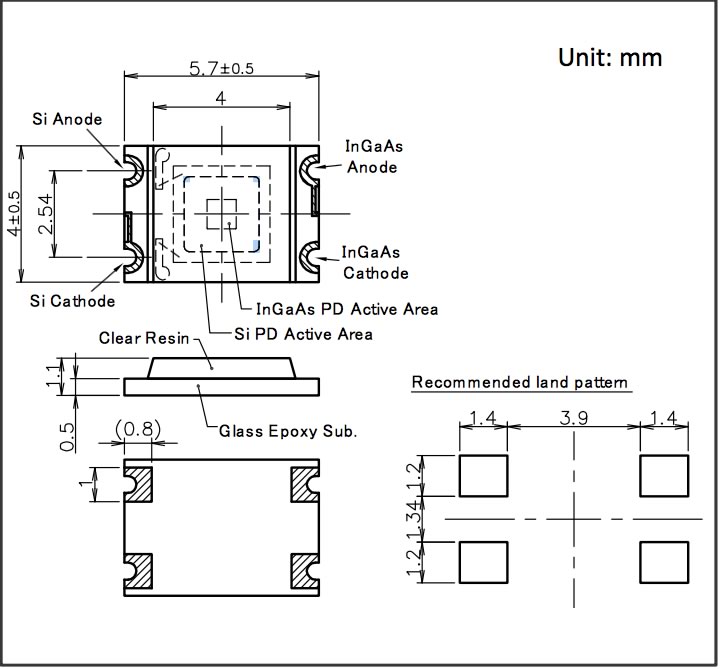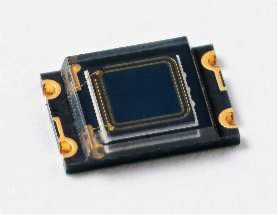Two-Tone Photodiode
Industry’s Smallest Two-Tone SMD Photodiode KPMC29, with a Broad Range of Sensitivity Wavelengths, from 400 to 1,700 nm
Applications
- Medical biometric monitoring devices (pulse oximeters, wearable activity monitors).
- Radiation thermometers that can measure temperatures without direct contact with hot objects.
Product Characteristics
- Wide range wavelength sensitivity (400~1,700nm)
KPMC29 is designed to cover wide wavelength range by stacking up two photodiodes (Si and InGaAs photodiodes) in the package with the same light axis. Si and InGaAs photodiodes are sensitive to shorter wavelengths and longer wavelengths respectively.
- Industry’s smallest surface-mountable package
KPMC29, Two-Tone Photodiode has a unique design in which Si photodiode die is mounted on top of the InGaAs die in a 4.0mm x 5.7mm x 1.1 package. This special design allows reduction of height and footprint of the package. The overall size has been reduced to 1/8 of our conventional products.
Samples will be available from August 31, 2020. Mass production orders will begin on April 1, 2021.
Featured Product
Si / InGaAs Two-tone Photodiode
Features
- Integrated Si and InGaAs photodiode
- Same optical axes configuration
- Wide sensitive wavelength range
- Low dark current
Applications
- Sensing component materials (gas, solute, etc...)
- Laser diode and LED monitors
- Wide range spectroscopy
Loading...
Loading...
Our Two-Tone Photodiode is a special type of photodetector that combines two different semiconductor photodiodes in one integrated package, aligned to the same optical axis, to achieve a very broad spectral response from UV/visible through SWIR (approximately 400 nm to 1700 nm). Specifically, this device (exemplified by the Kyoto Semiconductor KP-2 KPMC29 model which we offer in partnership) integrates a Silicon photodiode (sensitive in ~400–1100 nm range) with an InGaAs photodiode (sensitive ~900–1700 nm) in one package, with a dichroic filter separating the incoming light so each photodiode sees the part of spectrum it’s best at. The two-tone photodiode effectively acts as a single sensor with a very wide spectral range – something a single photodiode material cannot normally cover due to bandgap limitations. Key features of our two-tone photodiode include its same optical axis for both diodes (ensuring they sample the same light spot), wide range, relatively low dark current for both sensors (with appropriate cooling or biasing as needed), and availability in a compact, hermetic package.
Features and Advantages of the Two-Tone Photodiode
400 nm – 1700 nm Continuous Sensitivity
By combining Si and InGaAs diodes, the two-tone photodiode has a flat, wide spectral response that spans from the visible (just below 400 nm if well-calibrated) through the near-IR and into the short-wave IR up to 1.7 µm. This means one sensor can detect signals across this entire band. For applications like broadband spectrometers, light analysis, or communications that might use multiple wavelengths, this photodiode can capture them all simultaneously without having to use separate sensors and align them. For instance, in environmental monitoring, some instruments look at water’s absorption at 980 nm and 1450 nm and also visible spectra for other compounds; a two-tone PD can handle both ranges in one unit. Similarly, a telecom monitoring photodiode might need to watch both the 850 nm band and the 1550 nm band – this device can do that. Typical silicon PDs drop off after 1.1 µm, and InGaAs can’t see below ~900 nm well, so the hybrid covers the gap.
Single Optical Axis & Easy Alignment
The two photodiodes are integrated so that they view the same incoming light path – typically a beam enters the package, a short-pass filter reflects visible to the Si diode and transmits IR to the InGaAs behind it (or vice versa depending on design). This is all internal, meaning the user treats it like one sensor: there’s one window, you shine your light in, and internally it’s splitting to two detectors. This is much easier than trying to combine two separate photodiodes with external beam-splitters or calibration. In manufacturing or assembly, you don’t have to align two sensors to the same spot precisely – it’s pre-done in the device. This ensures both photodiodes measure the same spot of light, crucial for accuracy in spectral measurement. For example, in a spectrometer, you might scan a grating across wavelengths: with this two-tone PD, when the spectrum goes beyond Si’s range, the InGaAs naturally picks it up with the same geometrical view, simplifying design and improving consistency.
Low Dark Current & Noise for Both Segments
Each photodiode within the two-tone device is optimized to minimize dark current for its type. Silicon typically has very low dark current, and InGaAs, while higher, can be managed with cooling if needed or by using a smaller active area in these dual devices. Lower dark current means lower noise, which is critical for detecting weak signals, especially in SWIR. Our two-tone PD devices exhibit dark current and shunt resistance characteristics comparable to separate high-quality Si and InGaAs photodiodes. And because they are often PIN structures, they provide useful speed (typically microsecond response), with the integrated filter adding no meaningful noise and remaining stable within the hermetic package.
Space & Cost Savings
Using a single two-tone photodiode can be more cost-effective and compact than implementing a dual-detector setup externally. In handheld spectrometers or compact optical heads, board space and alignment cost are premium concerns. A portable NIR spectrometer for food analysis might want 600–1700 nm coverage; a two-tone PD consolidates detectors and alignment into one part, reducing component count and calibration overhead. One small InGaAs plus one Si die in a shared package can be cheaper and simpler than separate larger detectors and housings, improving yield and serviceability.
Key Enabler for Broad Spectrum Sensing
Modern applications increasingly need multi-spectral data: color meters with NIR for material ID, medical tissue sensors reading visible (oxygenation) and SWIR (water/fat), or environmental sensors tracking multiple constituents. The two-tone PD acts like a “single eye” that spans two materials’ strengths. In cultural heritage conservation, reflectance from UV through IR is measured to analyze pigments; a two-tone PD can cover the vis–SWIR range in one detector position. For solar monitoring, a diffuser plus a two-tone PD can measure irradiance broadly across ~350–1700 nm, simplifying radiometer design.
Applications of the Two-Tone Photodiode
Spectroscopy and Material Analysis
The two-tone photodiode is well-suited for compact spectrometers and optical analyzers requiring broad range. Portable NIR spectrometers in agriculture (fruit ripeness, grain composition) benefit by also capturing visible wavelengths. FTIR systems that cover vis–SWIR can use a two-tone PD for that portion. Labs measuring fluorescence with both visible and NIR components value the single-sensor continuity for faster setup and reduced calibration effort. In pharma QC, one detector can record tablet reflectance/transmittance from 400–1700 nm without swapping detectors.
Environmental and Climate Sensors
Monitoring sunlight, canopy reflectance, or atmospheric constituents often requires wide spectral data. Sun photometers can simplify from separate Si and InGaAs detectors to one two-tone PD with fixed bandpass filters for key wavelengths. Plant health sensors (NDVI and other vis+NIR indices) can improve accuracy by ensuring both bands are captured from the same spot using a single two-tone detector (e.g., up- and down-looking heads with appropriate optics/filters).
Biomedical Devices
Future oximetry and tissue diagnostics may employ more wavelengths (e.g., adding green or 1300 nm) to derive additional blood/tissue parameters. A two-tone PD can detect from ~500 nm through 1300+ nm in one optical axis. In benchtop analyzers, broad-spectrum absorption/fluorescence can be read with a single two-tone sensor, simplifying the optical path while maintaining separation of the Si and InGaAs channels for processing.
Optical Communications (WDM Monitoring)
In fiber networks, a two-tone photodiode can act as a broadband tap detector spanning key telecom bands, or in free-space links it can capture both an IR data channel and a visible alignment/beacon signal through the same aperture. This reduces receiver complexity and alignment steps.
Color and Light Meters
Devices that need concurrent illuminance (visible) and IR irradiance can replace two sensors with a single two-tone PD and application-specific filtering. High-end lux meters already use multi-spectral approaches; adding SWIR coverage via a two-tone detector extends capability to quantify NIR contributions relevant to heat load or safety assessments.
Overall, the two-tone photodiode is a cutting-edge component that significantly streamlines designs requiring broad spectral detection, providing unique capabilities that align with increasing multi-spectral demands. Tech-LED’s role in offering and supporting this component helps customers push sensor and measurement innovations further, with less complexity and more confidence in cross-spectrum matching.

